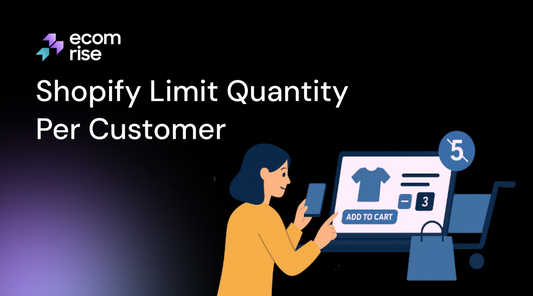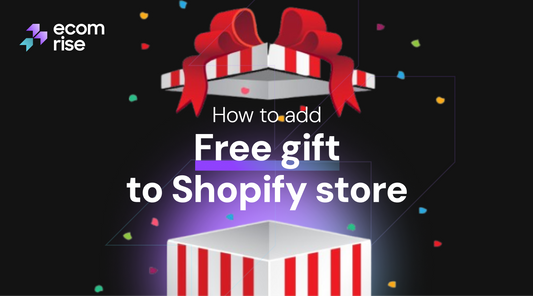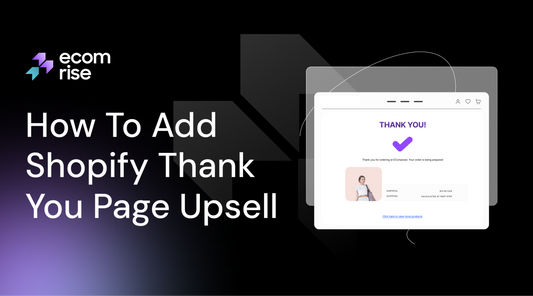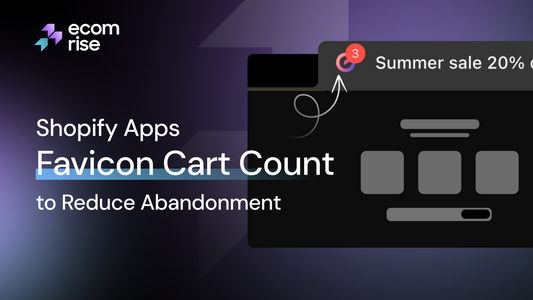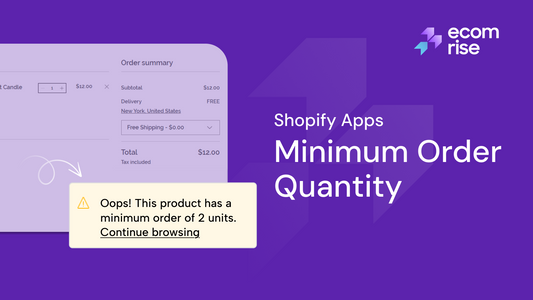How To Upsell On Shopify To Increase AOV (Guide & Tips)
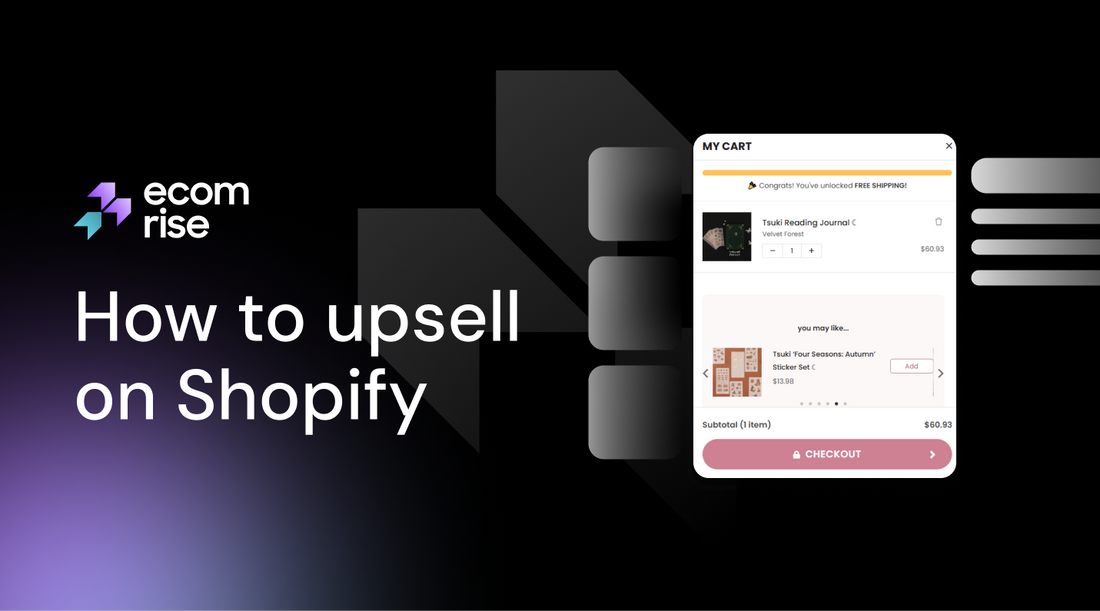
Looking to boost your Shopify store’s revenue without spending a fortune on ads? Upselling is your secret weapon! By cleverly encouraging customers to enhance their purchase, you can noticeably boost your average order value (AOV) and drive profits. In this guide, I'll share practical, proven Shopify upsell strategies and valuable tips to help you turn every transaction into a bigger win, both for you and your customers!
Understand the basics of upselling
What Is Upselling?
Simply put, upselling is a sales strategy where you encourage your customers to purchase a higher-end version of the product they're already interested in, or add extra features and upgrades that enhance its value. Think of it like ordering your favorite coffee, and the barista suggests going for a larger size or adding whipped cream and caramel drizzle, tempting, isn’t it?
In eCommerce and specifically on Shopify, upselling might look like recommending a more premium, feature-rich smartphone model when a shopper selects a basic version, or suggesting additional accessories that complement the main product.
Why Does Upselling Work?
Upselling is powerful because it taps into buyer psychology. Here’s why it works so effectively:
-
Customers are already interested: You’re suggesting something related to their original choice, which makes it relevant and less intrusive.
-
Boosts perceived value: Customers often appreciate it when you introduce them to better solutions they hadn't considered before, which can enhance their overall satisfaction.
-
Convenience factor: Customers love convenience, and offering them enhanced options right when they're ready to buy streamlines their shopping experience.
-
Win-win situation: Customers enjoy improved satisfaction through better products, and your business benefits from higher sales value — everyone leaves happy.
Difference Between Upselling vs. Cross-selling
While upselling and cross-selling might seem similar at first glance, understanding their subtle differences can greatly influence your sales approach:
-
Upselling: Motivating customers to choose a higher-priced option or premium version of the item they're already considering.
Example: Suggesting a smartphone model with increased storage when a customer selects a basic smartphone. -
Cross-selling: Offering complementary or related products that enhance or supplement the customer's initial choice.
Example: Suggesting a protective case or wireless headphones alongside a new smartphone.
In short, upselling elevates the customer's original choice, while cross-selling expands their order by introducing additional products that enhance their overall experience.
Benefits of Upselling on Shopify
-
The method serves to enhance Average Order Value (AOV) by making customers buy more products.
-
Customers achieve satisfaction through better discoveries when they shop because of product improvements.
-
Satisfied customers tend to make higher purchase repeat rates, which raises their total buying value over time.
-
Existing customer relationships become a lower-cost basis for revenue growth since upselling operations keep customer acquisition expenses minimal.
-
Sales of upscale items that carry higher profit revenues lead to improved company profits.
-
Effective inventory management happens through strategic product promotions that help manage stock better.
-
Built-in personalized upselling services create trust with customers, which produces loyal customers who repeat their purchases.
Top 9 Proven Upselling Strategies for Shopify Stores
1. Product Bundling
Product bundling involves grouping complementary products as one attractive package, typically at a slightly discounted price.
Why it works:
-
Shoppers perceive bundles as a better value, enticing them to purchase more than initially planned.
-
Simplifies buying decisions, enhancing customer satisfaction.
-
Helps move slow-selling items by bundling them with more popular products.
How to implement effectively:
-
Identify complementary products: Look at customer purchase history or sales data to find items commonly bought together.
-
Create attractive visuals and descriptions: Clearly demonstrate the value and benefits of purchasing the bundle instead of separate items.
-
Highlight savings: Clearly show customers how much they’re saving when choosing a bundle.
-
Promote bundles actively: Place bundles prominently on your homepage, collection pages, and within product pages.
-
Test bundle variations: Regularly experiment with different combinations and pricing to identify what resonates best.
Example:
A skincare bundle with face cleanser, moisturizer, and sunscreen is offered at 15% off, clearly showing the savings compared to individual purchases.
2. In-Cart Upsell
In-cart upsells suggest complementary items directly within the customer's shopping cart, right before checkout.
Why it works:
-
Captures the customer at a decisive moment, when they're already committed to buying.
-
Feels natural and relevant, encouraging impulse purchases.
How to implement effectively:
-
Strategically select products: Choose low-cost, high-margin, or complementary items relevant to the customer's cart contents.
-
Create urgency: Use persuasive copy such as, "Add this to your order for just $9.99 more!"
-
Simplify the addition: Make the process effortless, preferably with a single-click "Add to Cart" button.
-
Avoid overwhelming customers: Keep suggestions focused, typically no more than two or three items.
Example:
Customer adds a laptop bag; suggest a screen cleaner or protective sleeve right in the cart.
3. Personalized Recommendations
Tailored recommendations based on each customer’s browsing history, previous purchases, and interests.
Why it works:
-
Make customers feel recognized and understood, boosting loyalty.
-
Boost the chances of shoppers adding more to their cart.
How to implement effectively:
-
Businesses should capitalize on customer information by examining customers' historical purchase activities and their browsing records, as well as their demographic information.
-
Online retailers can enhance their sales through automated recommendation systems, which show personalized products directly to customers on their product pages as well as cart pages and through email communications.
-
Simple and attention-grabbing tags should be applied to recommendations through headers such as “Recommended for You” and “You Might Also Like.”
-
Regular performance checks of your suggestions should include evaluation of their relevance, along with conversion numbers to adjust your methods continuously.
Example:
A customer regularly buying fitness apparel receives personalized recommendations for matching accessories like gym bags, towels, or water bottles.
4. Membership/Exclusive Upsells
Offer premium upsells or special deals exclusively for members or subscribers, adding a sense of exclusivity and encouraging loyalty.
Why it works:
-
Enhances customer loyalty and lifetime value.
-
Motivates shoppers to join premium tiers or loyalty programs.
How to implement effectively:
-
Develop a clear membership structure: Clearly outline benefits of membership, such as early access, exclusive discounts, or special product lines.
-
Create urgency and exclusivity: Offer limited availability or member-only product lines.
-
Communicate regularly: Keep members engaged via exclusive newsletters or targeted email promotions.
-
Showcase member benefits publicly: Non-members will see the value and feel enticed to join.
Example:
Members receive early-bird access to premium sneakers, available exclusively for 48 hours before public launch.
5. Checkout Upsell
Display relevant upsell opportunities right at checkout to encourage last-minute additions.
Why it works:
-
Customers are already mentally prepared to spend, making additional purchases more likely.
-
Reduces friction by seamlessly integrating the upsell into the existing checkout flow.
How to implement effectively:
-
Choose complementary, impulse-driven items: Offer products related to the main purchase.
-
Limit decision complexity: Make checkout upsells simple and inexpensive relative to the customer's current cart.
-
Use persuasive messaging: Frame your offer attractively, e.g., “Complete your kit with this essential accessory for only $10!”
-
Test and optimize placement: Regularly monitor results and adapt accordingly for maximum conversions.
Example:
Customer checks out a phone; suggest a low-cost protective screen or pop socket.
6. Post-Purchase Upsells
The first opportunity to present more offers has direct delivery to customers using "Thank You" pages and follow-up emails right after their purchase.
Why it works:
-
Successful customers find more value in complementary promotions after finishing their initial transactions.
-
The demonstration of complementary offers maintains uninterrupted checkout without interrupting purchased products.
How to implement effectively:
-
After purchase completion, show complementary upsells through an attractive thank-you page that presents enticing offers.
-
You can flash post-purchase special savings that run for 15 minutes only.
-
You should deploy follow-up email marketing to show buyers the suitable products within the first 24 hours after they buy.
Example:
The camera buyer receives discounts for both memory cards and lens cleaning kits in direct succession after their purchase.
7. Limited-Time Offers & Scarcity Tactics
Strong time constraints and limited availability give customers a sense of urgency to drive them toward quick upsells.
Why it works:
-
Triggers a powerful psychological response (FOMO - Fear of Missing Out).
-
Drives quick purchasing decisions.
How to implement effectively:
-
Use countdown timers: Display visible timers for offers like "Only 6 hours left!"
-
Highlight scarcity: Clearly show limited quantities or limited-time availability, like "Only 5 units remaining!"
-
Include in promotional messaging: Reinforce urgency through email campaigns, website banners, and product pages.
Example:
“Upgrade to Premium Fabric today! Only 3 pieces left in stock, offer ends at midnight!”
8. AI-Powered Personalized Upsells
AI technology allows you to make personalized product suggestions at the right time, which align with customer actions along with their unique interests.
Why it works:
-
The solution provides the market's most tailored approach across all scales for higher conversion statistics.
-
The continuous learning ability of an AI system helps it improve its effectiveness as it develops through time.
How to implement effectively:
-
System integration with AI personalization analytics that tracks customer behavior should be implemented.
-
Customers must receive AI recommendations by placing these personalized upsell suggestions in prominent positions on product or checkout pages.
-
Monitoring while making adjustments depends on analytics to measure recommendation effectiveness for proper improvements.
Example:
An AI system delivers yoga accessory and nutrition product suggestions by analyzing customer buying behavior related to yoga clothing and gear.
9. Tiered Pricing & Volume Discounts
Offer progressively better discounts or perks when customers purchase larger quantities or premium product tiers.
Why it works:
-
Customers perceive greater value and savings, motivating bulk purchases.
-
Helps boost sales volume and AOV significantly.
How to implement effectively:
-
Clearly display tiered pricing: Communicate discounts explicitly (e.g., "Buy 1 for $20, Buy 3 for $50, Buy 5 for $75").
-
Highlight customer savings: Emphasize the cost advantage clearly, using visual charts or graphics.
-
Incentivize higher purchase volumes: Strategically set tiers to encourage bulk buying without sacrificing margin.
-
Promote actively: Highlight tiered offers on product pages, homepage banners, or email promotions.
Example:
A health-supplement brand offers “Buy 2 bottles, get 10% off; Buy 5 bottles, get 25% off, and free shipping.”
Hidden Upsell Tricks for higher conversion
1. Chatbot-Based Upselling
Using chatbots to upsell means engaging customers in real-time through conversational interactions, offering tailored recommendations right when shoppers need help the most.
Why it works:
-
Chatbots provide immediate responses and guidance, increasing customer confidence.
-
They deliver a shopping experience that feels tailored and interactive.
-
Seamlessly suggest products based on real-time customer interactions.
How to implement effectively:
-
Set up conversational chatbots: Choose chatbot tools that integrate directly with Shopify and allow product recommendations within the chat window.
-
Tailor your chatbot scripts: Train your chatbot with scripts that naturally suggest upsell items based on the customer's initial inquiries or selected products.
-
Proactively engage customers: Use the chatbot to trigger messages on high-value product pages, checkout pages, or when customers show signs of hesitation.
-
Human-like approach: Program your chatbot to use friendly, conversational language to enhance trust and build rapport.
Example:
-
When a shopper asks about a laptop, your chatbot automatically recommends complementary accessories, like laptop sleeves or docking stations, directly within the chat interface.
2. Spin-to-Win & Gamified Upsell Pop-Ups
Gamification techniques, such as "Spin-to-Win" wheels, encourage customers to interact with your site to unlock exclusive offers or discounts, indirectly leading to higher upsells.
Why it works:
-
Offers instant gratification and fun, boosting engagement.
-
Customers develop psychological commitment through the process of earning their discounted offers or promotions.
-
The improved user experience drives better acceptance of supplementary purchases from customers.
How to implement effectively:
-
Attractive pop-up designs should include innovative spin wheel interfaces along with game elements that showcase potential rewards in plain sight.
-
Provide motivating rewards that contain either premium discounts, together with buy-one-get-one special, or special time-limited package deals.
-
Time-limited discounts should be clearly presented to customers since their time-sensitive nature increases purchase speed.
-
Display gamified ads as exit-intent triggers, but also show them when visitors stay a threshold time on product pages and reach specific page depths.
Example:
-
A Spin-to-Win pop-up offering customers 10% off an upgrade, a free gift with a minimum spend, or discounted bundled items when they spin the wheel.
3. Social Proof-Based Upsells
Social proof-based upsells leverage customer reviews, testimonials, and real-time sales notifications to motivate additional purchases or upgrades.
Why it works:
-
Humans naturally trust the decisions of others — social proof validates and encourages buying decisions.
-
Adds authenticity to your recommendations, boosting customer confidence.
-
Creates urgency by showing popularity or scarcity.
How to implement effectively:
-
Display customer reviews: Showcase glowing reviews or star ratings right next to upsell recommendations, making it clear that many satisfied customers have already benefited.
-
Use real-time notifications: Show alerts like “20 people bought this bundle today,” or "50 sold in the last hour," to add urgency.
-
Incorporate influencer or expert opinions: Include influencer endorsements or expert testimonials alongside your upsell products.
-
Highlight best-sellers: Label recommended upsell items clearly with tags like "Customer Favorite" or "Most Popular."
Example:
-
On a supplement product page, show “Rated 4.9 stars by 300+ happy customers,” encouraging users to add complementary supplements or upgrades to their order.
4. Triggered Upsells Based on Customer Behavior
Behavior-triggered upselling refers to displaying tailored offers based on real-time actions, browsing history, or previous purchases, precisely when the customer is most receptive.
Why it works:
-
Offers highly targeted and relevant suggestions at exactly the right moment.
-
Significantly improves conversion rates due to precise timing and relevance.
-
Maximizes the effectiveness of customer data.
How to implement effectively:
-
Track customer behavior: Utilize tools or Shopify integrations that track browsing patterns, products viewed, or products added to the cart.
-
Automate personalized upsell pop-ups: Set up automated, behavior-triggered pop-ups or notifications tailored to customer interests (e.g., after viewing a product multiple times).
-
Segment audience: Create different upsell triggers for new versus returning customers or based on product-specific behaviors.
-
A/B test triggers: Continuously optimize which behaviors trigger upsells (scroll depth, exit intent, adding specific products to cart, or visiting certain pages repeatedly).
Example:
-
A customer repeatedly views a high-end camera. Trigger an upsell notification: "Looking at this camera? Get 10% off a premium accessory bundle today!"
5 Best Shopify Apps for Upselling in 2025
1. EcomRise
Shopify merchants strongly prefer EcomRise as their favorite platform due to its seamless integration and easy-to-use upselling features. The app uses intelligent AI recommendations together with aesthetically pleasing upsell offers to make purchases during the moment of engagement. EcomRise creates a straightforward yet strong tool for every eCommerce level to increase average order value swiftly.
Key Features:
-
Smart upsell & cross-sell recommendations.
-
The tool provides up-sell options throughout the cart process as well as after purchase completion.
-
Intuitive and beginner-friendly dashboard.
-
Analytics dashboard with real-time performance tracking.
-
Customizable templates and attractive design elements.
Pros:
-
Extremely user-friendly, even for beginners.
-
Excellent customer support and quick setup.
-
Flexible display options with beautiful designs.
-
AI-driven personalization boosts conversions significantly.
Cons:
-
Limited advanced analytics for large-scale stores.
-
Fewer integrations with niche apps.
Pricing:
-
Free Plan: Available (basic features)
-
Premium Plan: $9.99/month (advanced features)
2. EComposer
The combination in EComposer of enhanced page-building capabilities and delta selling functionalities creates an integral solution for Shopify store management. Users can create rewarding upsells with built-in featured or integrations, which enables codeless drag-and-drop operations and delivers multiple appealing, ready-built templates. EComposer delivers attractive designs to help merchants convert browsing customers into loyal customers by showing them specific attractive upsells.
Key Features:
-
Drag-and-drop upsell page builder with complete customization.
-
Integrated product bundle & upsell modules.
-
Rich collection of conversion-driven templates.
-
Seamless integration with Shopify themes & apps.
-
Optimized for page load speed and mobile responsiveness.
Pros:
-
Highly versatile, combining page-building and upselling in one.
-
Exceptional design flexibility with zero coding required.
-
Excellent for branded stores prioritizing visual consistency.
-
Outstanding customer support and guidance.
Cons:
-
Slight learning curve for absolute beginners.
-
Not specifically focused solely on upselling — more comprehensive.
Pricing:
-
Free Plan: All templates & basic upsell features
-
Paid Plans: Start from $19/month .
3. ReConvert
ReConvert is widely known as Shopify’s go-to app for powerful post-purchase upselling. It transforms your store's "Thank You" page into a prime opportunity for additional sales, presenting timely offers exactly when customers are most receptive, right after completing a purchase. ReConvert enables simple deployment, and its sophisticated functions combine countdown timers and offer targeting to elevate your store sales with no impact on the checkout process.
Key Features:
-
Customizable post-purchase upsell funnels.
-
Advanced customer segmentation for targeted offers.
-
Order timers and limited-time announcements appear on user thanks pages.
-
Robust A/B testing capabilities.
-
Integration with Shopify checkout and email marketing tools.
Pros:
-
The system displays a demonstrated capability to generate significant conversion rates after checkout completion.
-
Powerful yet simple to configure.
-
Real-time tracking of upsell performance.
-
Exceptional customer support.
Cons:
-
Post-checkout upsell strategies are its main strength, although this approach shows a limited effect on initial purchase promotion.
-
Users experience interface complexity because of the numerous features that appear.
Pricing:
-
The free version includes access to limited tasks.
-
Premium Plans cost $4.99/month and change based on the number of business orders processed.
4. Bold Upsell
Shopify merchants have trusted in Bold Upsell for many years because of its straightforward operation and impactful results. Customers can use Bold to easily upsell through its straightforward offerings of pop-ups alongside banners and customized recommendations, which are shown based on customer selection. Bold represents the application that brings reliable customer spending increases during checkout and delivers proven performance for all stores.
Key Features:
-
Simple product upsell offers at checkout or within the cart.
-
Advanced conditional upselling based on product selections.
-
Built-in analytics to track upsell revenue.
-
Attractive, customizable upsell pop-ups & banners.
-
Highly reliable backend and proven track record.
Pros:
-
Trusted by many Shopify merchants, proven effectiveness.
-
Easy setup with minimal technical knowledge.
-
Great customer support & extensive documentation.
-
Ideal for checkout and cart-page upselling.
Cons:
-
The design feels dated when compared to more modern alternatives.
-
Advanced personalization & AI-driven features are limited.
Pricing:
-
Free to install
-
Paid plan from $9.99/month
5. Zipify OneClickUpsell (OCU)
Zipify offers OneClickUpsell as a key system because its post-purchase upsell funnels function through one-click simplicity to raise revenue without complicating checkout. Zipify offers a solution designed for user-friendly operations that enables store owners to present timely post-checkout offers immediately following customer purchases. The combination of independent split-testing and simple design in OCU leads to higher sales conversions, which streamlines the growth process for Shopify store owners.
Key Features:
-
Single-click post-purchase upsell offers.
-
Advanced upsell funnel customization.
-
Integrated split-testing for maximum conversion rates.
-
Intuitive dashboard with real-time analytics.
-
Clients using mobile devices will find a seamless shopping experience, while payments require only one click.
Pros:
-
Highly effective post-purchase conversion rates.
-
Extremely user-friendly interface.
-
Customers can customize and test their advanced upsell funnel through the system.
-
Strong community & expert support.
Cons:
-
Premium pricing might be steep for smaller stores.
-
Primarily designed for post-checkout upselling — limited pre-checkout options.
Pricing:
-
Free for development stores
-
Starter plan: $8/month.
-
Unlimited plan: $35/month
How to Implement Upsell Tactics on Shopify
Step 1: Choose the Right Upsell App
Your selection of the right application will directly affect the achievement of your upsell strategy. Your store should opt for apps that fulfill its unique requirements and budget constraints and match your current operational level. Candidates should evaluate all features and pricing together with usability and support options.
What to compare:
-
You should select a system that offers in-cart upsells along with post-purchase upsells, together with AI-powered recommendations and customization choices, and analytics monitoring features.
-
The price structure needs evaluation to match both your financial plan and revenue projection.
-
The reliability and customer satisfaction of Shopify App Store applications can be evaluated through reading user reviews.
-
The application should abide by your existing Shopify theme standards and existing tools.
Recommended options:
-
EcomRise, EComposer
Step 2: Install and Configure the App
-
Go to the Shopify App Store, find and click "Add app."
-
Open the app, then select "Create Offer."
-
Choose trigger products (what customers select) and upsell products (what you suggest).
-
Configure discount options, messaging, and visuals to effectively persuade customers.
Step 3: Create Upsell Offers
Crafting appealing offers is critical to successful upselling. Your offers should be valuable, relevant, and clearly beneficial to customers.
Effective upsell examples:
-
Product Bundles:
"Buy these shoes and add matching socks and a cap at 15% off." -
Discounted Upgrades:
"Upgrade to a premium subscription for just $5 more!" -
Limited-time Offers:
"Special offer: Add a protective case today for 20% off." -
BOGO (Buy-One-Get-One) Deals:
"Buy one, get a second item for 50% off."
Keep offers straightforward, clearly highlighting customer benefits, and don’t overwhelm customers with too many choices.
Step 4: Test and Optimize
Testing and optimization are crucial to maximizing upsell conversions. Regularly A/B testing your offers helps identify what's most effective.
How to effectively A/B test:
-
Test variables such as offer placement, wording, images, pricing, and timing.
-
Run tests for at least 1-2 weeks or until you have statistically significant data.
-
Use built-in analytics in your chosen app to assess performance.
-
Continuously iterate, keeping successful elements and discarding ineffective ones.
Example:
-
Version A: “Add protective sleeve for $9.”
-
Version B: “Protect your device for just $9 – Limited-time offer!”
Monitor which converts better and adjust accordingly.
Step 5: Track Performance
Consistently tracking performance metrics ensures your upselling strategy stays profitable and aligned with business goals.
Key Metrics to Monitor:
-
Average Order Value (AOV): The average order value calculation enables you to assess whether your upsell offers boost transaction value.
-
Conversion Rate (Upsell Offers): Monitor the exact frequency of upsell offers acceptance for determining their success rate.
-
Revenue Generated by Upsells: To determine profitability, analyze revenue earned directly from upselling activities.
-
Customer Lifetime Value (CLV): The upsell program should be monitored for its ability to enhance the long-term customer value of participants.
-
Cart Abandonment Rate: Protect your cart abandonment rate from negative impacts caused by upselling initiatives.
Regularly review these metrics through Shopify’s dashboard or your chosen app’s built-in analytics to refine and improve your strategy continually.
By following these clear, actionable steps, you're now ready to successfully implement powerful upselling strategies in your Shopify store, turning ordinary transactions into extraordinary revenue growth!
Real-Life Examples of Successful Upselling
1. Amazon’s “Frequently Bought Together” Strategy
Amazon operates the popular "Frequently Bought Together" section on its website to offer strategic cross-selling recommendations for its customers. Customers who buy a product instantly witness complementary items combined in packages that suggest additional purchases. The strategy boosts Amazon’s typical order amount while satisfying customers by offering quick and convenient ways to get more value.
How to apply this to your Shopify store:
Placing recommended product sections adjacent to product descriptions or near the cart section will show customers additional logical add-ons or bundled products, which improve their overall experience.
2. Apple’s Strategic Product Upgrades
When customers approach the point of purchase, Apple makes conscious moves to display advanced versions of its products, including higher-tier models. When iPhone customers reach the point of purchase, they encounter an upgrade to higher storage capacity to highlight its advantages to them. The company presents these additional features as basic remedies that address everyday consumer problems (such as storage shortages).
How to apply this to your Shopify store:
The moment customers begin their purchase journey, present them with upgrade possibilities that display concrete advantages instead of technical specifications.
3. Dollar Shave Club’s Post-Purchase Upsells
The marketing strategy at Dollar Shave Club consists of post-purchase emails that aim to sell additional products to new customers right after their first purchase. The company uses follow-up subscription emails to recommend supplementary grooming products at temporarily reduced rates to new subscribers. This post-purchase method increases the long-term value of customers by effortlessly leading to additional purchasing occasions.
How to apply this to your Shopify store:
Send targeted, timely emails offering complementary or upgraded products after a customer makes a purchase, using personalized discounts or incentives to encourage immediate follow-up orders.
Mistakes to avoid and tips for effective upselling
Suggesting irrelevant or unrelated products:
-
Offering products customers don’t need or clearly wouldn’t be interested in damages trust.
-
Leads to annoyance and reduces upsell acceptance.
Excessive or intrusive upsell promotions:
-
Frequent pop-ups or aggressive messaging interrupt the shopping experience.
-
May cause customers to abandon their carts or leave your site entirely.
Poor timing of upsell offers:
-
Presenting upsells too early (before product selection) or too late (after checkout completion) reduces effectiveness.
-
Customers need offers at the moment they're most receptive, such as adding products to their cart or immediately post-purchase.
Overwhelming customers with too many choices:
-
Providing multiple upsell options simultaneously leads to decision fatigue.
-
Stick to one or two clear, compelling options to simplify customer decisions.
Neglecting mobile optimization:
-
Ignoring mobile device experience leads to poor usability and lost opportunities.
-
Mobile-friendly upsells increase acceptance rates among shoppers on smartphones and tablets.
Effective Upselling Tips for Higher Conversion
Provide highly relevant and personalized recommendations:
-
Analyze customer purchase history, browsing behavior, and preferences.
-
Example: Suggest premium headphones to a customer purchasing a smartphone.
Clearly communicate the value of the offer:
-
Highlight savings, additional benefits, or exclusive advantages.
-
Example: “Add this travel case now and save 20%!”
Perfectly time your upsell offers:
-
Present upsells clearly in the cart, during checkout, or immediately post-purchase to maximize conversions.
-
Example: Show a related accessory immediately after a customer adds a camera to their cart.
Use urgency and scarcity strategically:
-
Implement limited-time offers or low-stock notifications to encourage immediate action.
-
Example: “Only 3 left in stock — add now to secure yours!”
Limit the number of upsell options to avoid confusion:
-
Offer a maximum of two or three focused, strategic upsell items to reduce decision fatigue.
-
Example: Suggest one or two clearly beneficial items rather than an extensive list of choices.
Simplify the upsell acceptance process:
-
Allow customers to accept upsell offers with minimal friction, ideally one-click additions.
-
Example: “Click here to add this protective case to your order instantly.”
Consistently test, track, and optimize your upsells:
-
Regularly run A/B tests to identify which offers, designs, and placements yield the highest conversions.
-
Monitor essential metrics such as Average Order Value (AOV), conversion rate, upsell acceptance rate, and overall upsell revenue.
Final words
Upselling is one of the smartest, easiest, and most cost-effective ways to boost your Shopify store’s revenue and increase your Average Order Value (AOV). Your upselling process becomes effective by presenting matching upsales to customers at just the right time, which leads to satisfied consumers who remain loyal to your brand. Your Shopify store will experience success by beginning today to execute time-tested upselling methods and conducting ongoing enhancements of your approach.





